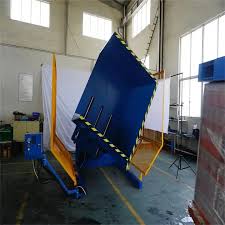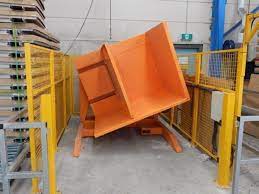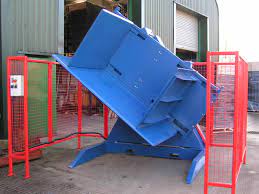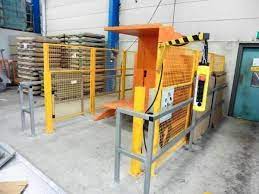Cutting Downtime in Spain: How Pallet Changing Machines Help
Your production line stops. A single damaged pallet is the culprit. This simple, frustrating problem causes massive delays and costs you money. Every minute of downtime bleeds your bottom line, a situation all too familiar for plant managers. Imagine this happening multiple times a week. The manual labor to transfer heavy loads is slow, risky, and can damage your valuable products. Your team is frustrated, and your efficiency targets are slipping away. This is a common story I hear from factory owners across Europe, including a recent client in Spain who faced this exact challenge. But what if you could swap a pallet in under a minute, automatically, without manual handling? This is where pallet changing machines come in, turning a major bottleneck into a seamless part of your operation.
Pallet changing machines help cut downtime by automating the process of transferring goods from one pallet to another. This eliminates the slow, manual labor required to re-stack products when a pallet is damaged, unsuitable for export, or needs to be swapped for an in-house pallet. By performing this task in as little as 60 seconds, these machines prevent production line stoppages, reduce labor costs, and minimize product damage, directly boosting operational efficiency and uptime.

It sounds simple, but the impact is profound. We've seen it firsthand with our partners, like a manufacturing plant in Spain that was struggling with this exact issue. But to truly understand the value, you need to look beyond the basic function. Let's break down how this technology works and why it's becoming a critical investment for smart factory owners who want to stay ahead.
What Exactly is a Pallet Changing Machine?
You see a broken wooden pallet under a ton of your finished product. You know you can't ship it like that. What's the plan? Do you ask a team of workers to manually unload and restack everything? This process is a productivity killer. It is slow, physically demanding, and introduces a huge risk of injury or product damage. Every time this happens, your workflow grinds to a halt. A pallet changing machine, or pallet inverter, is the engineered solution to this exact problem. It is a piece of equipment designed to safely and quickly transfer a full load of goods from one pallet to another.
A pallet changing machine is a stationary or mobile piece of equipment that securely clamps a palletized load, rotates or tilts it, and allows the original pallet to be removed and replaced with a new one. This process is done mechanically, often in under a minute, without disturbing the stacked products. It is a key tool for logistics, warehousing, and manufacturing to handle pallet quality issues, meet shipping requirements, or switch between wood and plastic pallets.

How a Pallet Changer Works: A Step-by-Step Breakdown
The core principle is simple: move the product, not the individual boxes or bags. A forklift places the entire loaded pallet into the machine. The machine then uses pressure plates to gently secure the load from the top and bottom. Once clamped, the magic happens. Depending on the machine type, it will either rotate the load a full 180 degrees, effectively putting the pallet on top, or tilt it 90 degrees to slide the load onto a new pallet. With the old pallet now accessible, the operator can easily remove it and slide a new one into place. The machine then gently returns the load to its upright position on the new pallet. The entire cycle, from loading to unloading, can be completed in about 60 seconds by a single operator, a dramatic improvement over manual methods.
Types of Pallet Changing Machines
Not all pallet changers are created equal. The right choice depends heavily on your product, your workflow, and your facility's layout. From my experience helping clients design their packaging lines, the selection process is critical. Choosing the wrong type can be just as inefficient as not having one at all.
| Machine Type | Mechanism | Best For | Key Consideration |
|---|---|---|---|
| 180° Inverter | Clamps the load and flips it completely upside down. | Robust, stable goods like bags of cement, canned goods, or blocks. | Not suitable for fragile or orientation-sensitive items that cannot be inverted. |
| 90° Tilter / Load Pusher | Tilts the load and gently pushes it from one pallet to another. | Stacks of boxes, crates, and semi-sensitive items with flat tops. | The load must be stable enough to be pushed without losing its shape. |
| Side-Clamping Changer | Clamps the load from the sides, lifts it, and swaps the pallet underneath. | A wide variety of loads, including those sensitive to tipping or pressure from the top. | Clamp pressure must be carefully calibrated to avoid damaging the product. |
| In-line Automated System | Integrated directly into a conveyor line for fully automatic transfers. | High-volume, fully automated production environments. | Requires significant upfront planning and integration with existing systems (MES/WMS). |
This last point about integration is key for forward-thinking leaders. A standalone machine offers flexibility, but an in-line system, which we often design for high-capacity plants, becomes a seamless part of a digital-first operation. It contributes to the kind of comprehensive efficiency that leaders in demanding industries are always seeking.
How Do Pallet Changers Directly Reduce Downtime?
Your shipping deadline is in an hour, but an export-bound pallet load is sitting on a chipped, domestic-grade wooden pallet. You are facing a potential delay and a disappointed customer. The "fire drill" begins. You pull workers from other tasks. They race against the clock, manually moving boxes. The risk of a dropped box or a strained back is high. This reactive, chaotic process is the definition of operational inefficiency. A pallet changer transforms this emergency into a routine, 60-second task. It directly attacks the source of the downtime: the manual transfer of goods.
Pallet changers directly reduce downtime by replacing a time-consuming, manual process with a rapid, automated one. Instead of taking 15-30 minutes for two workers to manually re-stack a load, a pallet changer completes the same task in about a minute. This speed eliminates production bottlenecks caused by pallet issues, allowing conveyor lines and loading docks to operate continuously. This was the core problem we solved for a client in Spain, whose logistics were constantly interrupted by substandard pallets.

Quantifying the Time Savings
The numbers speak for themselves. When I talk to plant managers, I always encourage them to do a simple calculation. Think about how many times a day you have to deal with a bad pallet. Let's imagine a moderate scenario and compare the two methods.
| Metric | Manual Method | With Pallet Changer |
|---|---|---|
| Time per Pallet Swap | 20 minutes | 1 minute |
| Labor Required | 2 workers | 1 operator |
| Risk of Product Damage | Medium-High | Very Low |
| Risk of Injury | Medium | Very Low |
| Total Time for 10 Pallets/Day | 200 minutes (3.3 hours) | 10 minutes |
The math is stark. You reclaim over three hours of labor time every single day. That time translates directly into available capacity. It means your workers can focus on value-added tasks instead of tedious, non-productive rework. This simple shift in process directly addresses the goal of increasing capacity utilization. It turns wasted time into productive time.
The Ripple Effect of Eliminating Micro-Stops
Downtime is not always one big, catastrophic failure. More often, it is a series of "micro-stops" that kill efficiency. A damaged pallet arrives at your automated stretch wrapper and snags the film. The wrapper faults and stops. This backs up the entire conveyor line behind it. Upstream processes are forced to slow down or stop completely. I remember visiting a factory in Spain where the brand-new automated wrapping line was constantly being paused. The operator blamed the wrapper. But after observing the line, I saw the real problem. The root cause was broken pallet boards entering the system. The wrapper was just the victim. By installing a pallet changer as a "quality gate" before the wrapper, they solved the problem. It ensured only good, uniform pallets reached the automated equipment. They did not just fix the wrapping issue; they made their entire end-of-line process more stable and predictable. This is how you achieve 95% uptime—by eliminating the small, cascading problems that add up to big delays.
What's the ROI on a Pallet Changer for a Heavy Industry like Steel?
As a leader in a capital-intensive industry like steel, every investment is scrutinized. You see the operational benefit, but you need to see the numbers. How can a machine that just swaps pallets justify its cost on a factory floor where every piece of equipment is a major capital expense? It is easy to dismiss it as a "nice-to-have" luxury. You might think, "My guys can handle it." But the hidden costs of the manual method are enormous. Wasted labor, damaged product, workers' compensation claims, and lost production time add up to a staggering figure. The Return on Investment (ROI) for a pallet changer is surprisingly fast and multi-faceted. It is calculated not just in saved labor, but in protected assets, improved safety, and maximized throughput.
The ROI on a pallet changer in a heavy industry like steel comes from three main areas: labor savings, reduction in product damage, and increased operational uptime. By automating pallet swapping, you can reassign labor to value-added tasks. By eliminating manual handling of heavy steel products, you prevent costly damage and write-offs. Most importantly, by preventing downtime, you maximize the output of your entire production line, leading to a typical ROI within 12-24 months.

Breaking Down the Cost Savings
For practical leaders like Javier, a business case must be built on hard numbers. Let's model a hypothetical but realistic scenario for a steel processing facility.
Assumptions:
- Value of steel product per pallet: $5,000
- Fully-loaded labor cost: $25/hour per worker
- Pallet swaps per day (due to damage, export needs, etc.): 15
- Manual swap time: 20 minutes with 2 workers
- Product damage rate during manual transfer: 1%
Annual Savings Calculation:
- Labor Savings: The cost of the manual method is significant. (2 workers $25/hr 0.33 hr/pallet 15 pallets/day 250 days/year) = $61,875 per year. The pallet changer requires one operator for about 2 minutes. The new cost is negligible in comparison, making the savings substantial.
- Product Damage Savings: Even a small damage rate is costly with high-value products. (15 pallets/day 250 days/year 1% damage rate * $5,000/pallet) = $18,750 per year. This is a direct saving to your bottom line.
- Downtime Savings: This is often the biggest contributor to ROI. If manual pallet swapping causes just 30 minutes of production line stoppage per day, that adds up to 125 hours per year. If your production line generates $5,000 in value per hour, that's $625,000 in recovered revenue opportunity.
The total quantifiable saving here is huge, and it makes the investment decision very clear.
The Strategic Value for a Steel Mill Owner
Beyond the direct ROI, a pallet changer has strategic value. In the steel industry, you are not moving boxes of chips; you are moving heavy steel coils, sheet stacks, or precision-cut components. Damage is not just a write-off; it is a major expense. A pallet changer provides a controlled, gentle transfer that protects these high-value assets. Furthermore, it is a key tool for global trade. Shipping steel internationally often requires specific heat-treated (HT) or plastic pallets to meet customs regulations. A pallet changer makes this transfer a simple, documented part of your process, preventing costly delays at port. Finally, for a leader focused on digital transformation, a modern pallet changer is not just a machine; it is a data source. It can integrate with your MES, providing cycle times and operational data to your analytics platform, helping you achieve true production visualization.
Beyond Downtime: What Other Benefits Can We Expect?
You have solved the downtime problem. Your line is running smoothly. But you are always looking for more ways to optimize. What else can this investment do for your operation? Focusing only on downtime means you might be missing half the value proposition. You could be overlooking major improvements in safety, hygiene, and warehouse logistics that also contribute to your bottom line. A pallet changing machine is a catalyst for wider operational excellence. Its benefits extend far beyond the seconds it saves, creating a safer, cleaner, and more flexible workflow.
Beyond reducing downtime, pallet changers offer significant benefits in worker safety, operational hygiene, and warehouse optimization. They drastically reduce the risk of musculoskeletal injuries associated with manual lifting. They enable easy separation of warehouse pallets from cleanroom or food-grade pallets. And they allow for the recovery of expensive pallets and the optimization of storage space by consolidating damaged loads.

A Major Leap in Workplace Safety
In heavy industry, workplace safety is not just a priority; it is a fundamental responsibility. Manual handling of heavy loads, like bundled steel bars or stacked plates, is a leading cause of serious musculoskeletal injuries. Back injuries, sprains, and strains can lead to lost workdays, high insurance premiums, and, most importantly, harm to your employees. Government bodies like OSHA have strict guidelines on manual handling for a reason: it is inherently risky. A pallet changer completely eliminates the need for manual restacking of heavy pallet loads. The cost of a single serious workers' compensation claim can easily exceed the cost of the machine itself. From my perspective as a factory owner, investing in equipment that designs risk out of the process is one of the smartest decisions a leader can make. It protects your people and your business.
Unlocking Logistical Flexibility
A pallet changer introduces a level of flexibility that streamlines many different logistical challenges. For example, many companies use high-quality, expensive rental pallets (like CHEP) for internal movements but need to ship products on cheaper, one-way pallets to avoid losing the expensive ones. A pallet changer makes this transfer fast and efficient. It also helps with warehouse optimization. Instead of having a "quarantine zone" filled with damaged pallets taking up valuable floor space, you can immediately transfer the goods to a new pallet and put the product back into inventory. This is especially critical for facilities that use automated systems like AGVs or an ASRS (Automated Storage and Retrieval System). These automated systems require perfect, uniform pallets to function. A pallet changer acts as a crucial bridge, ensuring that only system-compliant pallets enter your automated zones, which is a key part of any successful digital transformation project.
My Insights: Choosing the Right Pallet Changer for Your Steel Mill
I've spent my career on factory floors, first as an engineer and now as a factory owner myself. I know the pressures you face, Javier. When you are dealing with products worth thousands of dollars per pallet, like steel coils or wire, the stakes are incredibly high. The standard advice about pallet changers does not always apply. You need a solution built for the unique challenges of the steel industry. This is not about buying a machine; it is about implementing a solution.
Choosing the right pallet changer for a steel mill requires focusing on three key factors: robust construction to handle extreme weight, customized clamping mechanisms that secure uneven loads like coils without causing damage, and seamless integration with existing heavy-duty conveyor and wrapping lines. A standard, off-the-shelf machine is often not enough; you need a strategic partner who understands steel handling.
The Challenge of Weight and Load Shape
Steel products are not just heavy; they are dense and can have irregular shapes and concentrated centers of gravity. A standard pallet changer might be rated for 1500 kg, but can its structure withstand the dynamic forces of a shifting steel coil during rotation? At SHJLPACK, when we design equipment for the steel industry, we start with the frame. We use reinforced steel, oversized motors, and heavy-duty chains because the machine needs to be as tough as the product it is handling. Load stability is another major concern. A steel coil on a cradle or a bundle of rebar behaves very differently from a neat stack of boxes. The clamping system is critical. Standard flat pressure plates can damage a coil or fail to secure a bundle. This is why we design custom clamping solutions, like V-blocks or pressure-distributing pads, to secure these unique loads without marking or damaging the product.
Integration is Everything
In a modern steel mill, a pallet changer cannot be an island. It must be a seamless, integrated part of a larger system, which often includes orbital stretch wrappers for coils, automatic strapping machines, and heavy-duty conveyors. This is where our "TOTAL SOLUTION FOR WRAPPING MACHINE" slogan comes from. It is a philosophy. We do not just sell a machine. We analyze your entire end-of-line process. Where is the best place for the changer? Should it be before or after the wrapping station? How does it communicate with the safety interlocks and the main line controller? This is what a strategic partner does. This approach also aligns perfectly with the goal of digitalization. A modern pallet changer must be ready to connect to your MES and IoT platforms. It should be able to feed data—cycle counts, fault codes, swap times—directly into your central system. This turns a piece of mechanical equipment into a valuable data node for your smart factory. I have seen clients try to piece together systems from multiple suppliers, and it almost always leads to integration headaches and finger-pointing. My goal is to prevent that. By understanding your entire operation, we can ensure every piece of equipment works together perfectly from day one.
Conclusion
Investing in the right pallet changer is not just about cutting downtime. It is a strategic move to boost safety, protect your products, and build a more resilient operation.




